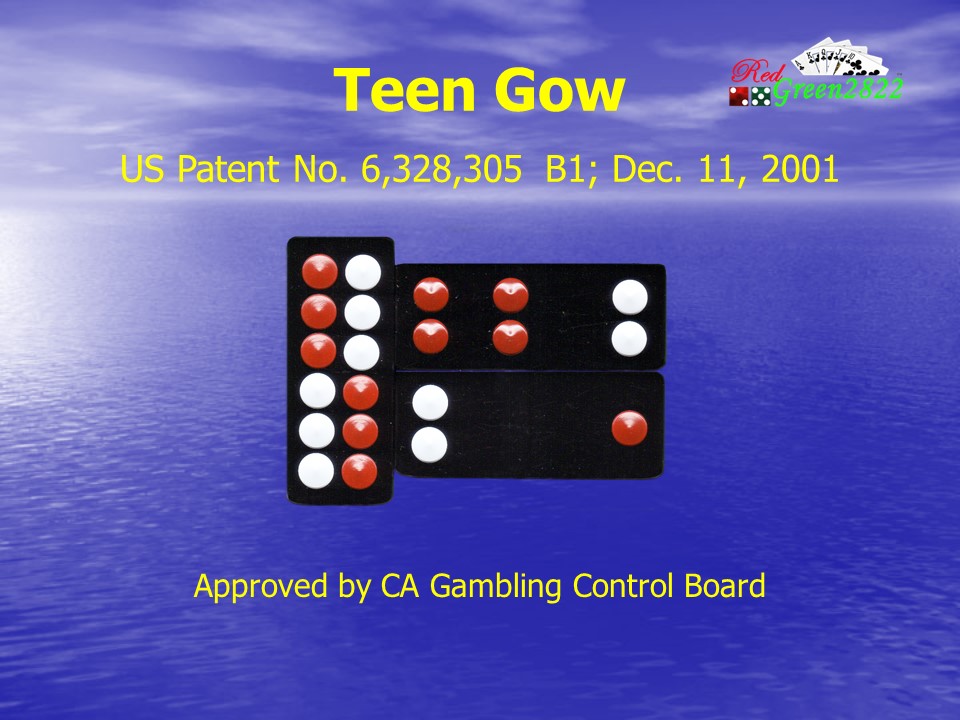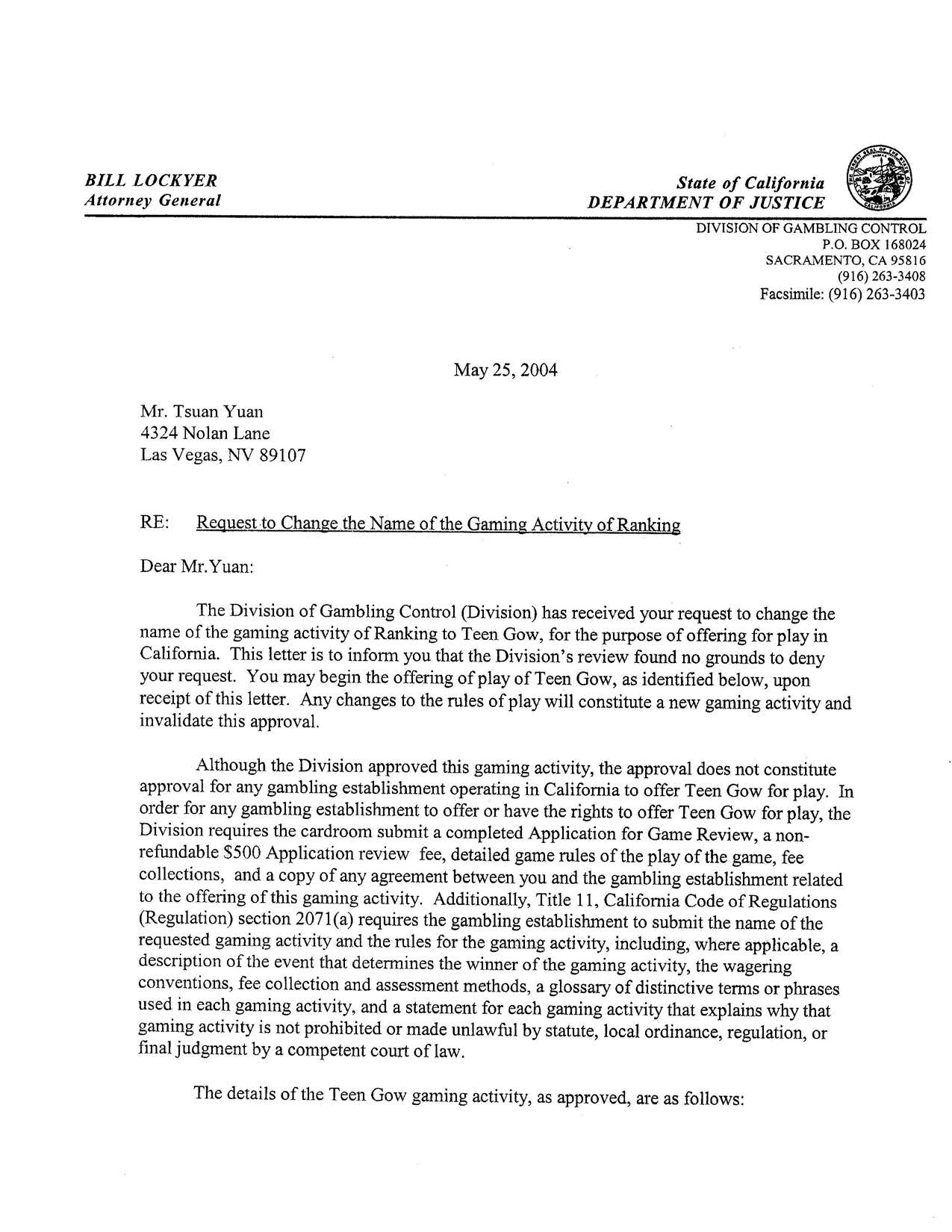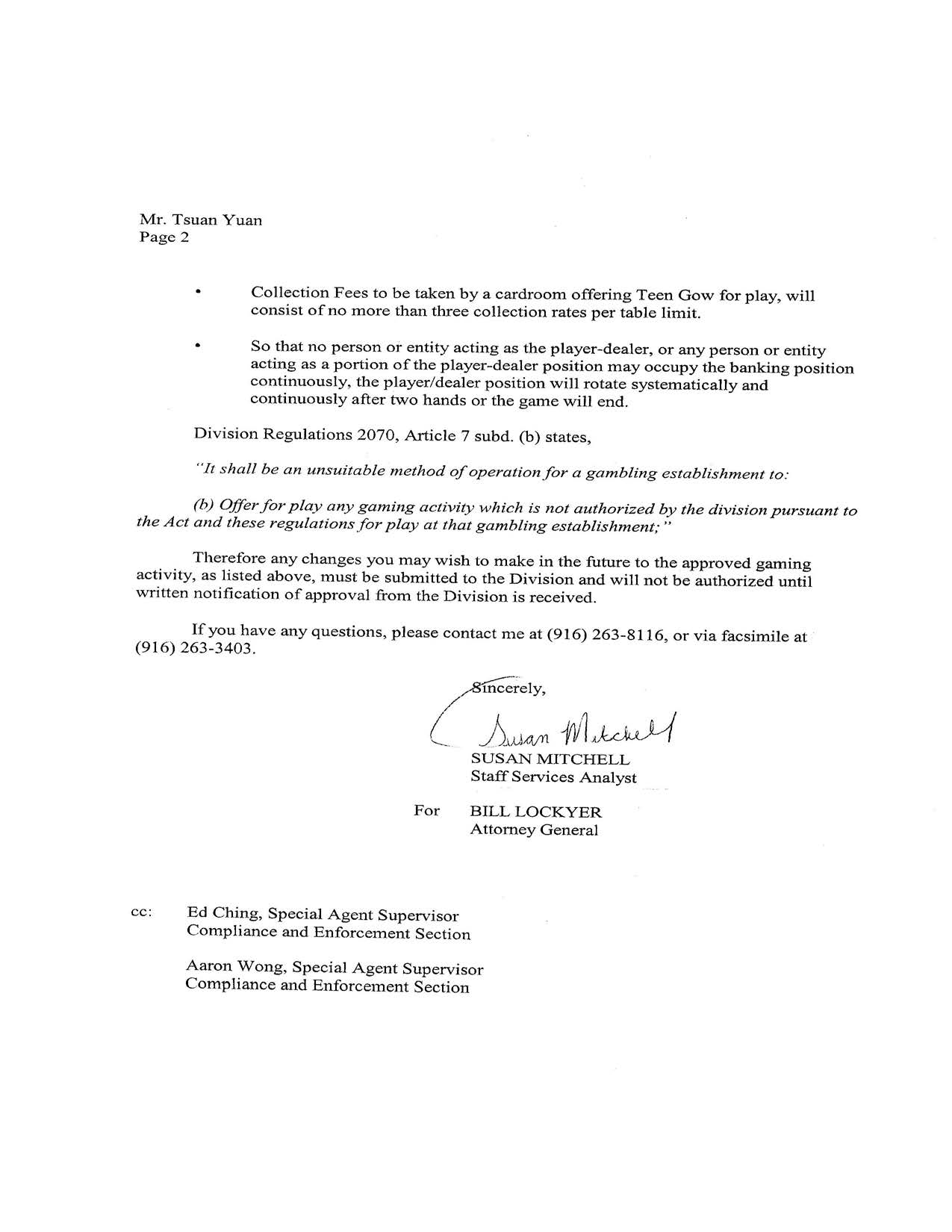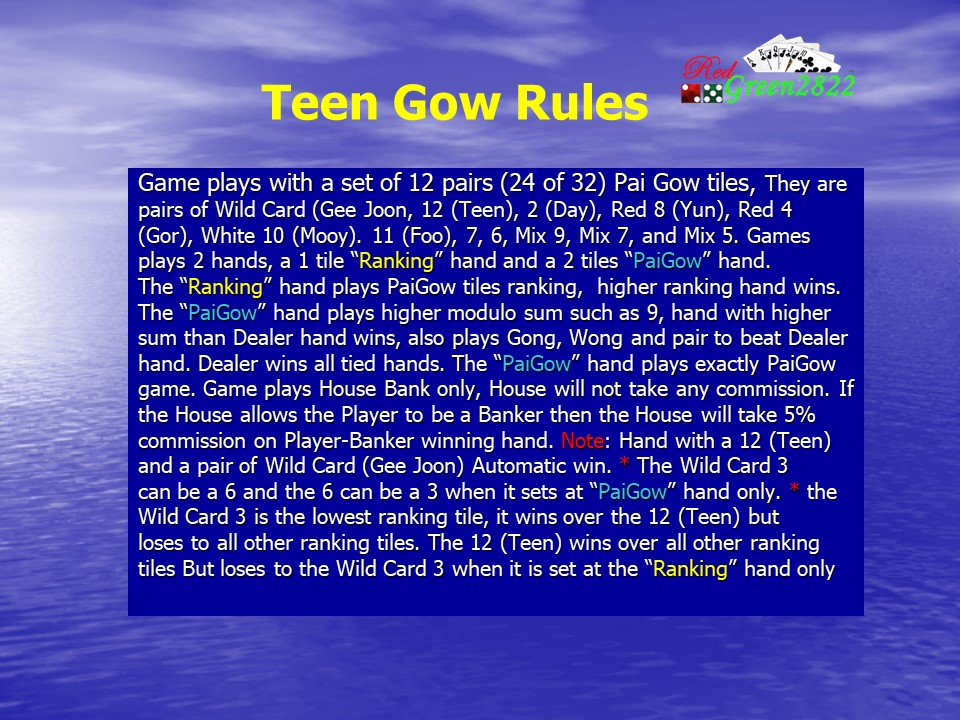TeenGow
天九
Table Sign
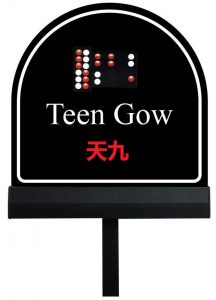
Layout
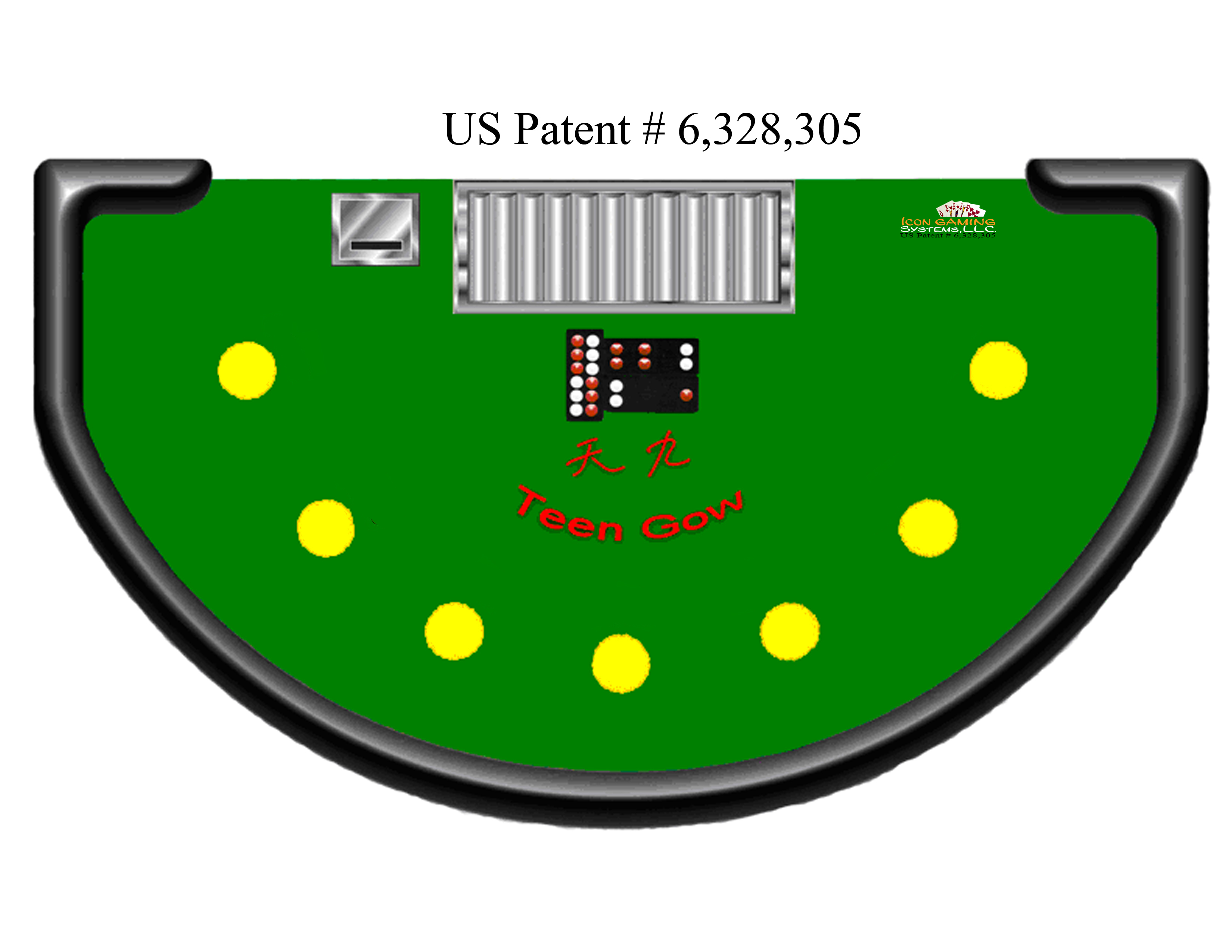
PLAYING RULES
The game requires at least one Player and a House Dealer. Each Player places an ante wager at the Player wagering area on the table layout. In this game, Players bet against Banker (Dealer), game plays House bank only, House will not take any commission on winning hand, or according to the House policy, House may allow the Player to take turn to be Banker just as Pai Gow game. House may take 5% commission on Player-Banker winning hand.
The game is played with a conventional set of twenty-four Chinese Pai Gow tiles, they are pairs of Wild- cards (Gee Joon), Twelve (Teen), Deuce (Day), Red Eight (Yun), Red Four (Gor), White Ten (Mooy), Eleven (Foo), Seven, Six, Mix-Nine, Mix-Seven and Mix-Five. After the tiles are randomized, such as through shuffling and stacking into eight stacks of three tiles. then the Dealer shakes the dice cup which contains 3 dice, the total of the three dice is determined who the Player or the Dealer receives the first set of three tiles. The Banker’s position are 1, 9 and 17. The Players and the Banker are numbered in a counter-clockwise fashion according to their locations. The location assigned the number rolled receives the first set of three tiles, other sets of three tiles are distributed in sequence to the Players and the Banker in counter-clockwise order, the betting circles without a wager is also received a set of three tiles. Any set of three tiles without a wager are removed from the play. No other tiles are dealt during game play.
The Banker and the Players arrange their hands into two component hands, a two-tile “PaiGow hand” It plays same as Pai Gow game and a single-tile “Ranking” hand, plays the tiles ranking. In arranging the Dealer hand, the Dealer has to play the optimum strategy as follows:
- If the Dealer has one tile with Twelve, Two, Eight, or Four pips, this tile is used as the “Ranking” hand, unless the Dealer has an exception hand described below.
- If the Dealer has two tiles with Twelve, Two, Eight, or Four pips, the lower tile is used as the “Ranking” hand unless the Dealer has a Twelve and a Two, in which case the Twelve is always used as the “Ranking” hand or the PaiGow” hand should be 4 or higher, or an exception hand described below.
- If the Dealer has three tiles with Twelve, Two, Eight, or Four pips, the following rules apply:
- For a hand with a Twelve, Two, and Eight, the Twelve is used as the “Ranking” hand.
- For a hand with a Twelve, Two, and Four, the Twelve is used as the “Ranking” hand.
- For a hand with a Twelve or Two, Eight, and Four, the Four is used as the “Ranking” hand.
If the Dealer does not have any tiles with Twelve, Two, Eight, or Four pips, the two tiles with the greatest PaiGow of pips are used in the “PaiGow” hand. For example, if the Dealer has a hand with a Seven, a Mix-Nine and a Mix-Seven, the Dealer has to form two tile “PaiGow” hand using the Mix-Nine and the Mix-Seven then the high 7 set as “Ranking” hand.
How to Play – House Way
The four highest ranking tiles are (in order) 12, 2, 8, and 4, with the 12 being the highest of the four. The hands are set as below.

A. A hand has one of the four highest ranking tiles. Set that tile as the “Ranking” hand, placing the other two as the “PaiGow” hand, except exceptions hands (see below).
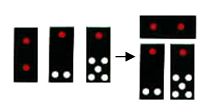
B. A hand has two of the four highest ranking tiles. Set the lower of the two as the “Ranking” hand, except exceptions hands (see below). However, if the “PaiGow” hand is not four or better, set the higher ranking tile as the “Ranking” hand or try to make two high hands.
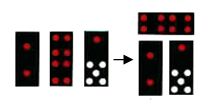
C. A hand has a 12 and a 2; Always set the 12 as the “Ranking” hand.
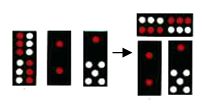
D. A hand has three of the four highest ranking tiles. Set as below:
1. 12 + 2 + 8. Set the 12 as the “Ranking” hand.

2. 12 + 2 + 4. Set the 12 as the “Ranking” hand.

3. 12 or 2, + 8 + 4. Set the 4 as the “Ranking” hand.
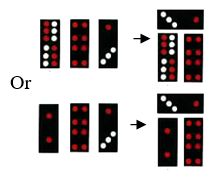
E. A hand without any of the four highest ranking tiles. Set the “PaiGow” hand as high as possible.
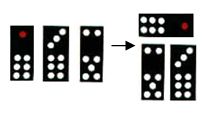
Exception Hands
A. A hand has a 4 + Wild Card + 12, 2, 8, 10, 9 or any 7. Set the 4 and Wild Card as the “PaiGow” hand.

B. A hand has a 4 + 5 + 2, 6, any 7, 8, 9, 10, 11 or 12. Set the 4 and 5 as the “PaiGow” hand.

C. A hand has a 12 or a 2, + 9 + 11 or 7. Set the 11 or 7 as the “Ranking” hand.

D. A hand has a 12 or 2 + Low 7 + 6,set as “Ranking” hand or any 7 Set the H7 as the “Ranking” hand.
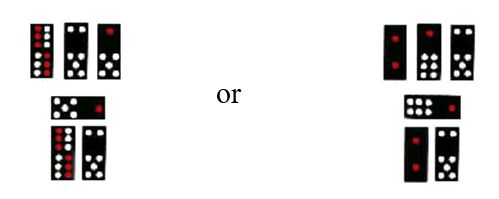
E. A hand has a 4 or an 8, + 10 + 11. Set the 10 as the “Ranking” hand.
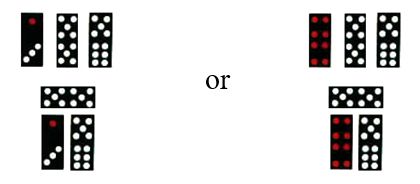
F. A hand has an 8 + 9 + 11. Set the 9 as the “Ranking” hand.

G. A hand has a 4 + 11 + 9. Set the 11 as the “Ranking” hand.
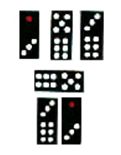
Splitting Pairs:
- Split pair of 12 with any domino except for 2,4,10 and 11.
- Split pair of 2 with any domino except for 4,8,10,11 and 12.
- Split pair of 8 with 11 only.
- Split pair of 4 with 5 only.
- Never split pairs of 5, 6, 7, Mix 7, Wild Cards, 9, 10 and 11.
Comparison
After all the Players are done setting their hands, they will place the “Ranking” hand vertically, and places the “PaiGow” hand perpendicularly to the left of “Ranking” hand. The tiles are placed face down above the betting circle. The Banker (Dealer) then sets his/her hand by the House’s rules as described as above. In arrange Player hands The Player is free to arrange his/her hand as he/she wishes and is not required to follow the optimum strategy.
The House Dealer will compare his/her hands to each Player hands from the Dealer right to left in counter-clockwise, the Dealer compares his/her “PaiGow” hand and “Ranking” hand to each Player’s “PaiGow” hand and “Ranking” hand, respectively. The “PaiGow” hands are ranked in descending order as follows:
In the event of the Player and the Dealer have identical sums of the “PaiGow” hand, then the ranking of the “PaiGow” hand card is compared and the higher-ranking card wins. For example: Player has a “PaiGow” hand with a 9 and a 10 equal (9) while the Dealer “PaiGow” hand has an 8 and 11 equal (9) The Dealer “PaiGow” hand is a winner because the ranking of the 8 is higher than the ranking of 10.
The “Ranking” hands are ranked in descending order as follows: 12, 2, 8, 4, 10, 11, 7, 6, Mix-9, Mix-7, Wild tile-6, Mix-5, and Wild tile-3 as shown in the attached figure. For example, (1) The Player “Ranking” hand has an Eight (Yun) while the Dealer “Ranking” hand has a Two (Day), the Dealer “Ranking” hand is a winner, because the ranking of the Two is higher than the ranking of the Eight. (2) The Player “Ranking” hand has a Five (Mix Five) while the Dealer “Ranking” hand has a Wild tile Three, the Player “Ranking” hand is a winner, because the ranking of Five is higher than the ranking of the Wild tile Three. (3) The Player “Ranking” hand has a Four (Gor) while the Dealer “Ranking” hand has a Seven, the Player “Ranking” hand is a winner, because the ranking of Four is higher the ranking of Seven.
A Player hand is declared the winner if the Player “PaiGow” hand and “Ranking” hand outrank the Dealer “PaiGow” hand and “Ranking” hand, respectively. A winning Player hand is paid at even money based on the Player ante wager.
A Dealer hand is declared the winner if the Dealer “PaiGow” hand and “Ranking” hand outrank the player “PaiGow” hand and “Ranking” hand, respectively. Also, a Dealer hand is declared the winner if one of the Dealer component hands outranks the corresponding Player component hand and the remaining Dealer component hand ties the corresponding Player component hand. (Banker (Dealer) wins on all ties hands)
A push is declared if one of a Player component hand outranks the corresponding Dealer component hand while the remaining Dealer component hand outranks or ties the remaining Player component hand. A push results in the Dealer merely returning the Player’s ante wager
Note: (A) The wild tiles – The Six can be 3 and the Three can be 6 when they are set as the “PaiGow” hand only and are the lowest ranking tiles.. (B) The wild tile – The Wild tile Three, when it is set as the “Ranking” hand, it is a lowest ranking tile but it could outrank the Twelve (Teen) only, but loses to all other ranking tiles. The Twelve outrank all other ranking tiles. (C) Special hand – If a Player hand or the Dealer hand receives a Twelve and a pair of Wild cards (Gee Joon) his/her hand is an automatic winning hand.
Note: If the Player “PaiGow” hand has the total sum of pips is equal to 0 (Zero), it is an automatic losing hand. (same as Pai Gow game).
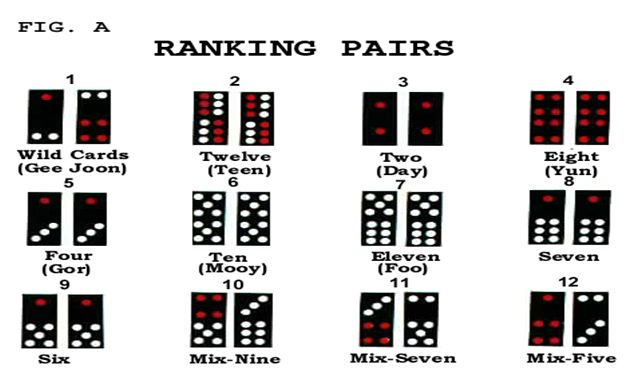
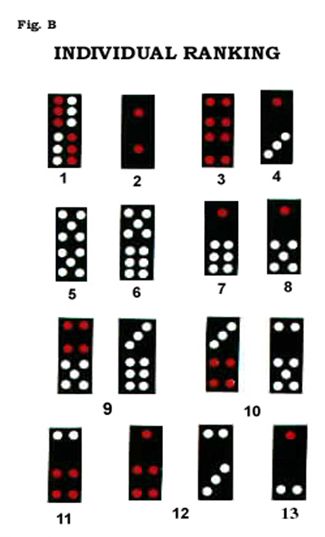

ANALYSIS
Rules of Play
Ranking is a new casino table game using Chinese Pai Gow tiles. It is played with a subset of 32 Pai Gow tiles and can be played by seven players against a house dealer.
The composition of the set of tiles is as follows:
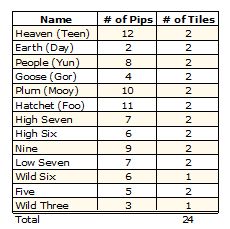
Hand Rankings (from highest to lowest)
Pairs
Gee Joon (Wild 6 and Wild 3)
Heaven
Earth
People
Goose
Plum
Hatchet
High Seven
High Six
Nine
Low Seven
Five
Wong
Heaven + Nine
Earth + Nine
Gong
Heaven + People
Earth + People
Individual
Heaven
Earth
People
Goose
Plum
Hatchet
High Seven
High Six
Nine
Low Seven
Wild Six
Five
Wild Three
The game begins with each player making a wager. The dealer deals 3 tiles to the dealer and to each player. The dealer and each player arrange the dealt tiles into a single-tile (front) hand and a two-tile (back) hand. Unlike Pai Gow, the front hand need not be stronger than the back hand.
Bets are resolved by first comparing the rank of the player’s front hand with the dealer’s front hand. The front hand with the higher ranking is the winning front hand. Next, the dealer compares the player’s back hand with the dealer’s back hand. Standard Pai Gow ranking is used for ranking the back hand. If the two-tile point total of the player’s back hand equals the two-tile point total of the dealer’s back hand, the dealer will compare the rank of the higher ranking tile of the player’s back hand with the higher ranking tile of the dealer’s back hand. In the event of a tie, the dealer always wins.
The player is paid even money if the player wins both front and back hand. The player loses his bet if the dealer wins both hands, or wins one hand and ties the other hand, or ties both hands. Players are not allowed to bank. The house does not charge a 5% commission on any player winning hand.
If played in the front hand, the Wild Three beats a Heaven but loses to all other tiles. If and only if played in the back hand, the Wild Six can be 3 or 6 and the Wild Three can be 6 or 3. If the player has a Heaven in the front hand and the Gee Joon pair in the back hand, it is an automatic winner.
The 2-tile back hand rankings are given in the following chart.

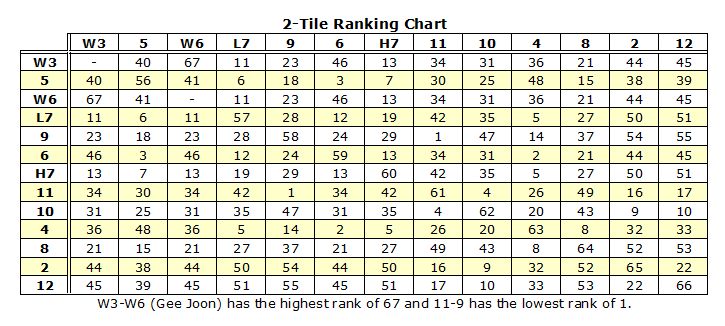
House-way Strategy
- Pair
- Never split a pair of 5s, 6s, any 7s, Gee Joon, 9s, 10s and 11s.
- Split a pair of 12s except with a 2, 4, 10 or 11.
- Split a pair of 2s except with a 4, 8, 10, 11 or 12.
- Split a pair of 8s only with an 11.
- Split a pair of 4s only with a 5.
- Nonpair
- Play the highest ranking tile in the front hand if a hand contains one of the top four tiles: 12, 2, 8 and 4.
- Play the 2nd highest tile in the front if a hand contains two of the top four However, if the 2-card hand will be lower than 4 points or the two highest tiles are 12 and 2, then play the highest ranking tile in the front.
- If a hand contains 3 of the top four tiles:
- 12 + 2 + 8 or 4: Play the 12 in the front.
- 12 or 2 + 8 + 4: Play the 4 in the front.
- With no top four tiles, strengthen the back hand as much as possible.
- Exceptions
- 4 + Wild card + 2, any 7, 8, 9 10 or 12: play the 4 and the wild card in the back.
- 4 + 5 + 2, 6, any 7, 8, 9, 10, 11 or 12: play the 4 and the 5 in the back.
- 12 or 2 + 9 + H7 or 11: play Wong in the back.
- 12 or 2 + any 7 + 6 or any 7: play high 9 (12 or 2 + 7) in the back.
- 10 + 11 + 8 or 4: play the 10 in the front.
- 8 + 9 + 11: play the 9 in the front.
- 4 + 9 + 11: play the 11 in the front.
Note that the house-way strategy is not optimal because it has to be simple enough for dealers to commit to memory.
Mathematical Analysis
There are C24,3 * C21,3 = 2,024 * 1,330 = 2,691,920 ways to deal 3 tiles to a player and then 3 tiles to the dealer from the remaining 21 tiles. However, there are only 418 distinct 3-tile hands, each of which can be arranged in 3 ways (2 ways if there is a pair) at most. With 3 tiles removed from the deck, there can be 265 to 382 ways to deal the dealer hands from the remaining deck.
A computer program was written to cycle through all distinct player-dealer combinations. For each distinct 3-tile player hand, the software removed the 3 tiles from the deck, arranged the hand in all possible ways, compared each arrangement with all dealer hands from the remaining deck and noted down the results. The play that yielded the highest expectation was chosen as the optimal play. The house advantage was determined as soon as all 418 player hands were examined. Given the above house-way strategy, the house advantage is 3.1791%, thereby obviating the need to charge a 5% commission on the player winning hand.
A player who employs the optimal strategy will win 20.06%, lose 23.24% and push 56.70% of the time. An automatic winner for the player will occur 2/2024 = 0.0988% of the time. Not that the player can’t be allowed to bank because the player banker will have the edge even if a 5% commission is charged.
The accuracy of the analysis was verified by a computer simulation of 500 million hands. The optimal player strategy along with the house strategy is shown below:

Presented By: Stanley Ko
GAMBOLOGY – PO Box 82225 – Las Vegas, NV 89180 – (702) 258-9685
June 26, 2002
